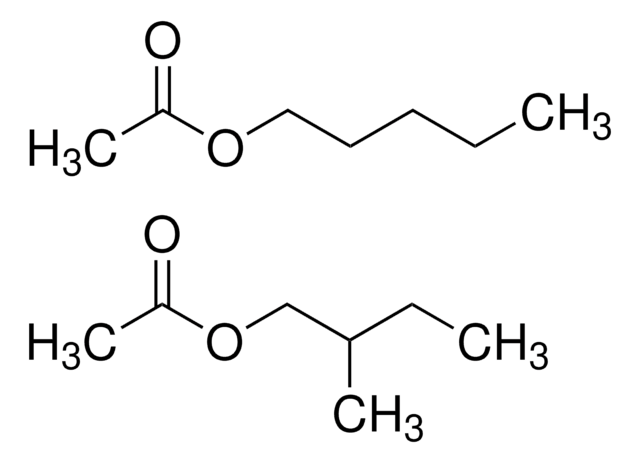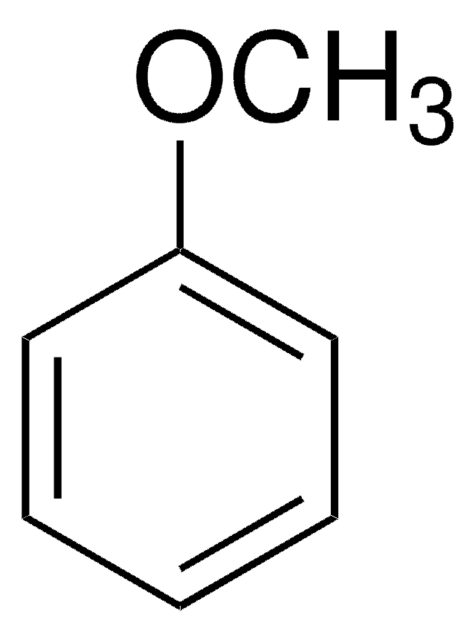8.18700
n-Amyl acetate
EMPLURA®
Synonim(y):
n-Amyl acetate, Pear oil, n-Pentyl acetate, Acetic acid pentyl ester
About This Item
Polecane produkty
ciśnienie pary
6 hPa ( 20 °C)
Poziom jakości
linia produktu
EMPLURA®
Próba
≥98.0% (GC)
Postać
liquid
temp. samozapłonu
350 °C
siła działania
>1600 mg/kg LD50, oral (Rat)
granice wybuchowości
1.1-7.5 % (v/v)
tw
149 °C/1013 hPa
mp
-71 °C
temp. przejścia
flash point 41 °C
rozpuszczalność
10 g/L
gęstość
0.87 g/cm3 at 20 °C
temp. przechowywania
2-30°C
InChI
1S/C7H14O2/c1-3-4-5-6-9-7(2)8/h3-6H2,1-2H3
Klucz InChI
PGMYKACGEOXYJE-UHFFFAOYSA-N
Opis ogólny
Zastosowanie
- Use of a habituation-dishabituation test to determine canine olfactory sensitivity.: This study by Moser et al. examines the use of a habituation-dishabituation test to measure olfactory sensitivity in dogs. The research explores the detection threshold of various odorants, including n-Amyl acetate, highlighting its application in behavioral studies involving canines (Moser et al., 2022).
- Enhancement of olfaction by femtomolar concentrations of zinc ions.: Ishimaru investigates the effects of zinc ions on olfactory sensitivity, showing significant enhancement even at femtomolar concentrations. The study uses n-Amyl acetate as a reference odorant to demonstrate improved olfactory function (Ishimaru, 2022).
- Generalization and discrimination tasks yield concordant measures of perceived distance between odours and their binary mixtures in larval Drosophila.: Chen and Gerber study the perception of odor mixtures in larval Drosophila, using n-Amyl acetate to assess generalization and discrimination tasks, which reflect the perceived distance between odors (Chen & Gerber, 2014).
- SML resist processing for high-aspect-ratio and high-sensitivity electron beam lithography.: Mohammad et al. present advancements in SML resist processing, using n-Amyl acetate in the fabrication process for high-aspect-ratio and high-sensitivity applications in electron beam lithography (Mohammad et al., 2013).
Komentarz do analizy
Density (d 20 °C/ 4 °C): 0.875 - 0.877
Identity (IR): passes test
Informacje prawne
Hasło ostrzegawcze
Warning
Zwroty wskazujące rodzaj zagrożenia
Zwroty wskazujące środki ostrożności
Klasyfikacja zagrożeń
Flam. Liq. 3
Zagrożenia dodatkowe
Kod klasy składowania
3 - Flammable liquids
Klasa zagrożenia wodnego (WGK)
WGK 1
Temperatura zapłonu (°F)
105.8 °F
Temperatura zapłonu (°C)
41 °C
Certyfikaty analizy (CoA)
Poszukaj Certyfikaty analizy (CoA), wpisując numer partii/serii produktów. Numery serii i partii można znaleźć na etykiecie produktu po słowach „seria” lub „partia”.
Masz już ten produkt?
Dokumenty związane z niedawno zakupionymi produktami zostały zamieszczone w Bibliotece dokumentów.
Klienci oglądali również te produkty
Nasz zespół naukowców ma doświadczenie we wszystkich obszarach badań, w tym w naukach przyrodniczych, materiałoznawstwie, syntezie chemicznej, chromatografii, analityce i wielu innych dziedzinach.
Skontaktuj się z zespołem ds. pomocy technicznej











